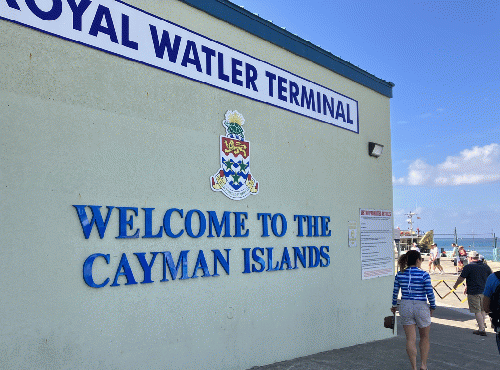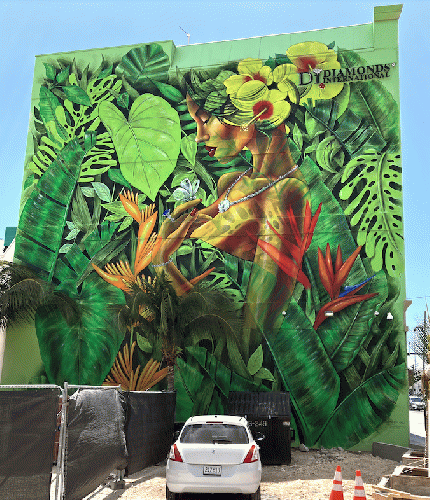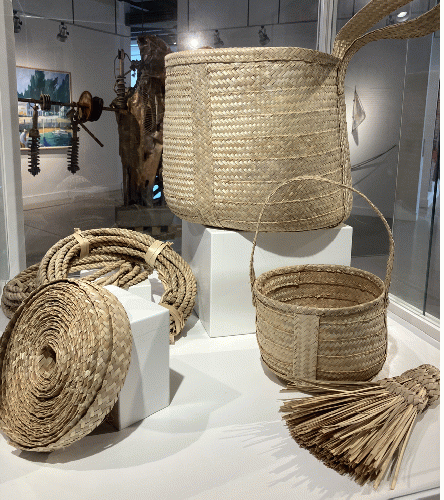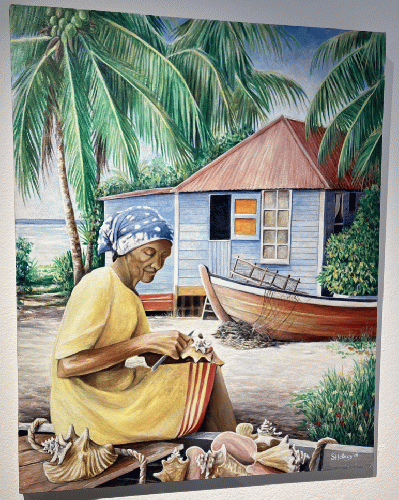Grand Cayman Island was the first port on my Caribbean cruise. While other cruise-goers were eager to swim with stingrays or snorkel at Seven Mile Beach, I decided to check out the art at The National Gallery of the Cayman Islands.
Most Caymanians are of mixed African and European ancestry, and the official language is English, which makes communicating easy for the average mono-linguistic American.
The Caymans have the highest standard of living in the Caribbean. The nation's low tax rates have famously led to it being used as a tax haven for corporations; there are 100,000 companies registered in the Cayman Islands, more than the population of just under 80,000.
Current exhibitions at the The National Gallery of the Cayman Islands featured the work of native Caymanians.
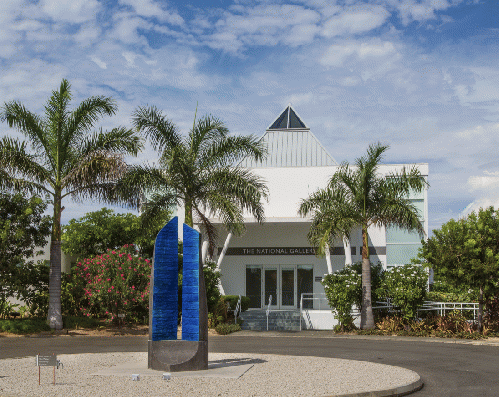
National Gallery of the Cayman Islands
(Image by National Gallery of the Cayman Islands) Details DMCA
The Ties That Bind exhibition (through March 24, 2023) explores the multiple ways in which Caymanian artists have depicted the Islands' rich cultural legacy.
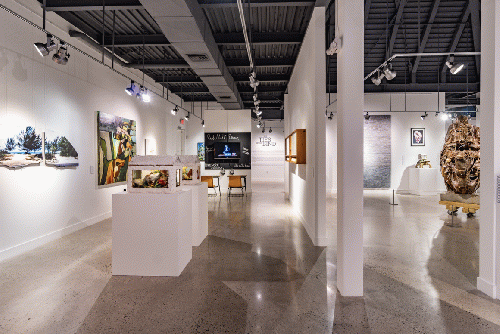
Galleries at National Gallery of the Cayman Islands
(Image by National Gallery of the Cayman Islands) Details DMCA
The Silver Thatch palm is Cayman's national tree and offers a foundation for weaving a variety of artistically created, utilitarian items:
Top L-R: Utility Basket, 2019 by Elizabeth 'Lizzie' Powell (b. 1937); and Thatch Basket, c.2017 by Rose May Ebanks (b. 1951). Woven from silver thatch palm, these are examples of traditional Caymanian thatch weaving and the commonly used baskets that were worn across the body for carrying provisions.
Bottom, L-R: Thatch Rope Cart, 2012, by Marlena Anglin (b. 1933). Wood silver thatch rope. This cart is a typical example of the traditional devices once used to twist silver thatch rope. From the 1800s until the 1960s the rope making industry provided a major source of income in Cayman reaching its height in 1964 when 1.3 million fathoms of rope were exported. Prior to the industry's decline in the late 1960s the rope making process was often a family activity with women gathering and twisting the thatch and children helping to turn the strands. Basket with Utensils. 2013 by Marlena Anglin. Silver thatch palm. This basket and assortment of practical utensils including a thatch bristle brush. The grouping spotlights the various functional uses of silver thatch products in everyday Caymanian life.
We Can Beat the Storm, 1993, by Miguel Powery:
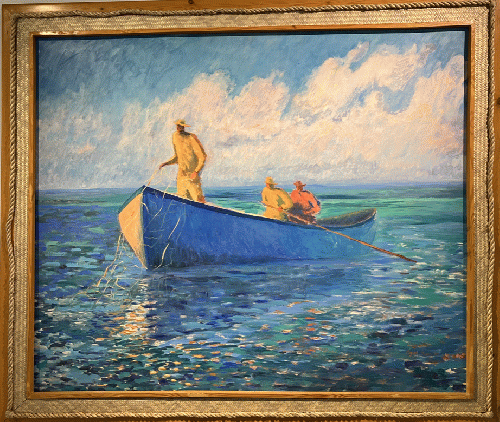
We Can Beat the Storm, 1993 by Miguel Powery (b. 1957). Acrylic on canvas
(Image by Photo by Meryl Ann Butler) Details DMCA
Old Time by Stewart Holmes depicts a woman cleaning conch shells, a laborious task. The conch is important in Caymanian culture as a food and decorative accent in traditional sand yards, and recently as tourist souvenirs.
Harbour Drive by Joanne Sibley depicts the George Town harbour in the mid-1990s before the large cruise ships began to arrive. Most of these buildings are no longer there, however, the one with the red roof is the oldest surviving public structure in the Cayman Islands, and is now the site of the National Museum.
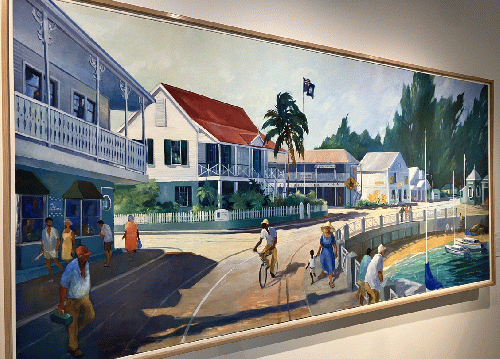
Harbour Drive. 1995 by Joanne Sibley (b. 1930) Oil on canvas Gift of Coutts.
(Image by Photo by Meryl Ann Butler) Details DMCA
Looking Glass by Simon Tatum refers to the traditional device used by Caymanian fishermen to spy turtles underwater. In this self-portrait, it also symbolizes the quest for self-knowledge.
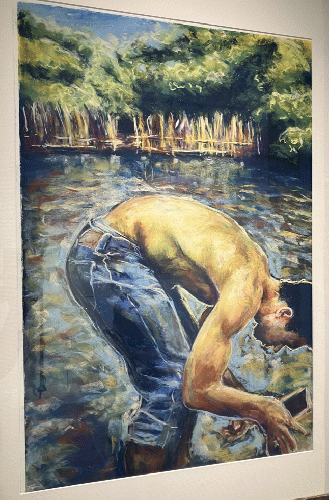
Looking Glass. 2015. by Simon Tatum (b. 1995). Ink and pastel on paper
(Image by Photo by Meryl Ann Butler) Details DMCA
Sewing Lady, by Margaret Barwick depicts a woman engaging in domestic labor in a traditional Caymanian cottage; women were the backbone of the Islands' community.
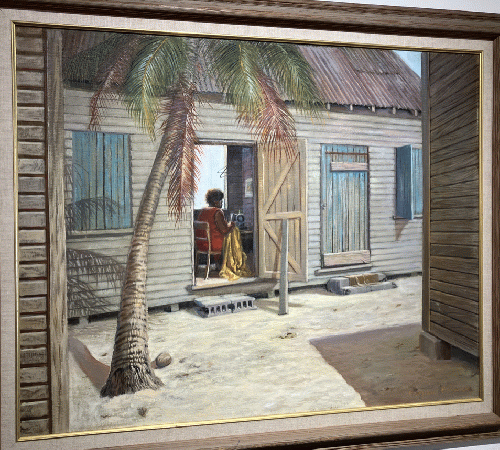
Sewing Lady, 1978 by Margaret Barwick (b. 1931). Oil on canvas Collection of the late Arden Shaw and Family
(Image by Photo by Meryl Ann Butler) Details DMCA
Another exhibition, Miss Lassie: An Intuitive Spirit, was curated by Daniela Granados Solis in partnership with the Cayman National Cultural Foundation. Daniela personally guided me around the whole museum.
A fourth-generation Caymanian, Miss Lassie's primitive artistic practice began at the age of 62, following what she described as a transformational 'visionary experience'. She began decorating everything in her wattle and daub cottage with vibrant blends of cultural and religious imagery, with what she called "markings."
The Ten Sails by Miss Lassie depicts the historic shipwreck event that occurred off the East End of Grand Cayman on 8 February 1794. Ten ships that were part of a convoy on its way from Jamaica to the United States and Britain wrecked on the surrounding reef. Local residents braved the stormy waters and successfully rescued most of the ships' crews and passengers.
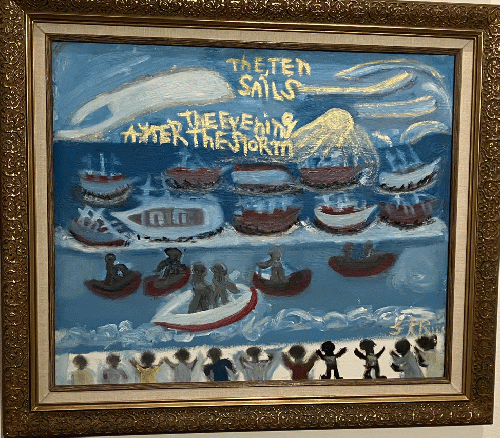
The Ten Sails, by Miss Lassie. c 1990. Mixed media on canvas Col. of the Cayman National Cultural Foundation
(Image by Photo by Meryl Ann Butler) Details DMCA
Why Are Ye Gazing Up in the Sky is a celebratory illustration of the ascension of Jesus as he triumphantly returns to heaven, witnessed by eleven disciples. Note the three dimensional treatment of the noses.
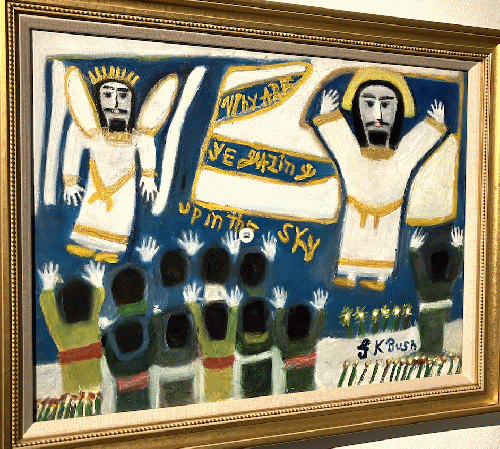
Why Are Ye Gazing Up in the Sky, c.1992 by Miss Lassie. Oil on canvas Col. of the Cayman National Cultural Foundation
(Image by Photo by Meryl Ann Butler) Details DMCA
Miss Lassie's primitive style is akin to the works of America's Grandma Moses, and Nova Scotia's Maud Lewis.
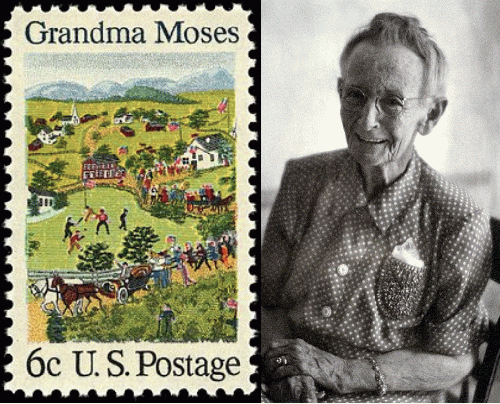
Primitive painter, Grandma Moses, and a postage stamp featuring her art
(Image by Wikipedia (commons.wikimedia.org)) Details DMCA

Maud Lewis, primitive painter of Nova Scotia
(Image by Wikipedia (commons.wikimedia.org), Author: Author Not Given) Details Source DMCA
Outdoors at the museum you can enjoy a sculpture garden and walk the Dianne Siebens Memorial labyrinth.
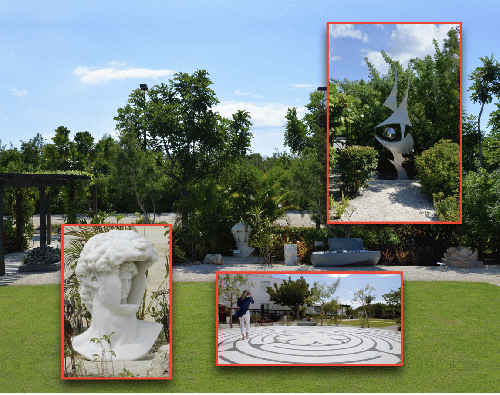
Sculpture Garden at the National Gallery of the Cayman Islands
(Image by National Gallery of the Cayman Islands) Details DMCA
The National Gallery of the Cayman Islands
Physical address: Esterly Tibbetts Hwy | Grand Cayman | Cayman Islands
Mailing Address: PO Box 10197 | KY1-1002 | Cayman Islands
Phone +1 (345) 945 8111



